
Illustrative Math Alignment: Grade 6 Unit 1
Dividing Fractions
Lesson 6: Using Diagrams to Find the Number of Groups
Use the following Media4Math resources with this Illustrative Math lesson.
| Thumbnail Image | Title | Body | Curriculum Nodes |
|---|---|---|---|
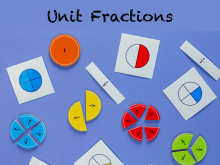
|
Math Clip Art Collection: Unit Fractions | OverviewThis collection aggregates all the math clip art around the topic of Unit Fractions. There are a total of 10 images. This collection of resources is made up of downloadable PNG files that you can easily incorporate into a presentation. |
Identify and Name Fractions |

|
Math Clip Art Collection: Unit Fractions | OverviewThis collection aggregates all the math clip art around the topic of Unit Fractions. There are a total of 10 images. This collection of resources is made up of downloadable PNG files that you can easily incorporate into a presentation. |
Identify and Name Fractions |
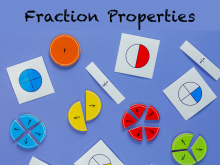
|
Math Clip Art Collection: Properties of Fractions | OverviewThis collection aggregates all the math clip art around the topic of Properties of Fractions. There are a total of 12 images. This collection of resources is made up of downloadable PNG files that you can easily incorporate into a presentation. |
Identify and Name Fractions |

|
Math Clip Art Collection: Properties of Fractions | OverviewThis collection aggregates all the math clip art around the topic of Properties of Fractions. There are a total of 12 images. This collection of resources is made up of downloadable PNG files that you can easily incorporate into a presentation. |
Identify and Name Fractions |

|
Math Clip Art Collection: Properties of Fractions | OverviewThis collection aggregates all the math clip art around the topic of Properties of Fractions. There are a total of 12 images. This collection of resources is made up of downloadable PNG files that you can easily incorporate into a presentation. |
Identify and Name Fractions |

|
Math Clip Art Collection: Properties of Fractions | OverviewThis collection aggregates all the math clip art around the topic of Properties of Fractions. There are a total of 12 images. This collection of resources is made up of downloadable PNG files that you can easily incorporate into a presentation. |
Identify and Name Fractions |

|
Math Clip Art Collection: Properties of Fractions | OverviewThis collection aggregates all the math clip art around the topic of Properties of Fractions. There are a total of 12 images. This collection of resources is made up of downloadable PNG files that you can easily incorporate into a presentation. |
Identify and Name Fractions |

|
Math Clip Art Collection: Properties of Fractions | OverviewThis collection aggregates all the math clip art around the topic of Properties of Fractions. There are a total of 12 images. This collection of resources is made up of downloadable PNG files that you can easily incorporate into a presentation. |
Identify and Name Fractions |

|
Math Clip Art Collection: Properties of Fractions | OverviewThis collection aggregates all the math clip art around the topic of Properties of Fractions. There are a total of 12 images. This collection of resources is made up of downloadable PNG files that you can easily incorporate into a presentation. |
Identify and Name Fractions |

|
Math Clip Art Collection: Properties of Fractions | OverviewThis collection aggregates all the math clip art around the topic of Properties of Fractions. There are a total of 12 images. This collection of resources is made up of downloadable PNG files that you can easily incorporate into a presentation. |
Identify and Name Fractions |

|
Math Clip Art Collection: Properties of Fractions | OverviewThis collection aggregates all the math clip art around the topic of Properties of Fractions. There are a total of 12 images. This collection of resources is made up of downloadable PNG files that you can easily incorporate into a presentation. |
Identify and Name Fractions |
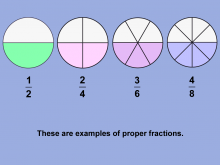
|
Math Clip Art--Fraction Concepts--Proper and Improper Fractions 05 | Math Clip Art--Fraction Concepts--Proper and Improper Fractions 05TopicFractions DescriptionThis image provides examples of proper fractions shown as circular fractions: 1/2, 2/4, 3/6, and 4/8. It displays four circles, each divided into the appropriate number of sections with the corresponding number of sections shaded to represent each fraction. This visual representation helps students see that these fractions, while written differently, all represent proper fractions (less than one whole). It reinforces the concept of proper fractions and introduces the idea of equivalent fractions. |
Identify and Name Fractions |

|
Math Clip Art--Fraction Concepts--Proper and Improper Fractions 04 | Math Clip Art--Fraction Concepts--Proper and Improper Fractions 04TopicFractions DescriptionThis image is a variation of the previous one, now showing that for a proper fraction, a < b. It displays the fraction a/b again, but with an additional note or visual indicator that the numerator (a) is less than the denominator (b). This representation introduces the concept of proper fractions, helping students understand that when the numerator is less than the denominator, the fraction represents a part of a whole that is less than one. |
Identify and Name Fractions |
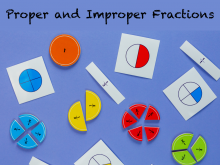
|
Math Clip Art--Fraction Concepts--Proper and Improper Fractions 01 | Math Clip Art--Fraction Concepts--Proper and Improper Fractions 01TopicFractions DescriptionThis image serves as the title card for a series on proper and improper fractions. It displays the text "Proper and Improper Fractions" in a clear, prominent font. The background may include subtle mathematical elements or fraction-related graphics to set the context for the following images in the series. This introductory image sets the stage for the subsequent images, preparing students for an exploration of the differences between proper and improper fractions. It provides a clear, concise title that immediately informs viewers about the specific fraction concepts they'll be studying. |
Identify and Name Fractions |
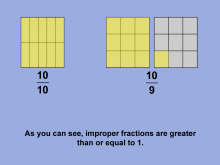
|
Math Clip Art--Fraction Concepts--Proper and Improper Fractions 10 | Math Clip Art--Fraction Concepts--Proper and Improper Fractions 10TopicFractions DescriptionThis image is a variation of the previous one, now showing visual models for 10/10 and 10/9. It displays rectangular visual representations: one divided into 10 parts with all 10 parts shaded, and another pair of rectangles divided into 9 parts with 10 parts shaded. This representation helps students understand that improper fractions include fractions equal to one whole (like 10/10) as well as those greater than one whole (like 10/9). It reinforces the concept that improper fractions have numerators greater than or equal to their denominators. |
Identify and Name Fractions |
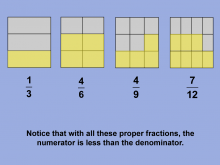
|
Math Clip Art--Fraction Concepts--Proper and Improper Fractions 06 | Math Clip Art--Fraction Concepts--Proper and Improper Fractions 06TopicFractions DescriptionThis image presents a variation of the previous concept, now using rectangular models to show proper fractions: 1/3, 4/6, 4/9, and 7/12. It displays four rectangles, each divided into the appropriate number of sections with the corresponding number of sections shaded to represent each fraction. |
Identify and Name Fractions |

|
Math Clip Art--Fraction Concepts--Proper and Improper Fractions 07 | Math Clip Art--Fraction Concepts--Proper and Improper Fractions 07TopicFractions DescriptionThis image shows another variation with these fractions: 1/4, 3/8, 5/12, and 15/16, emphasizing that proper fractions are less than 1. It displays visual models for each fraction, clearly showing that the shaded portion is less than the whole in each case. This representation further reinforces the concept of proper fractions, showing examples with increasingly larger denominators. It helps students understand that even as fractions get closer to 1, they remain proper fractions as long as the numerator is less than the denominator. |
Identify and Name Fractions |
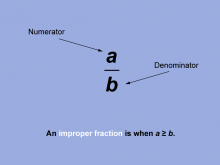
|
Math Clip Art--Fraction Concepts--Proper and Improper Fractions 08 | Math Clip Art--Fraction Concepts--Proper and Improper Fractions 08TopicFractions DescriptionThis image introduces the concept of improper fractions, stating that a fraction a/b is improper if a is greater than or equal to b. It displays the fraction a/b with a visual or textual explanation indicating that when the numerator is greater than or equal to the denominator, the fraction is improper. This representation helps students understand the definition of improper fractions and how they differ from proper fractions. It sets the stage for exploring fractions that represent one whole or more than one whole. |
Identify and Name Fractions |
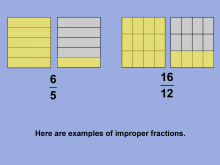
|
Math Clip Art--Fraction Concepts--Proper and Improper Fractions 09 | Math Clip Art--Fraction Concepts--Proper and Improper Fractions 09TopicFractions DescriptionThis image provides visual models of improper fractions using rectangular models for 6/5 and 16/12. It shows two rectangles: one divided into 5 parts with 6 parts shaded (extending beyond the original rectangle), and another divided into 12 parts with 16 parts shaded. This representation helps students visualize improper fractions and understand that they represent more than one whole. It demonstrates how improper fractions can be represented visually, even when they exceed one complete unit. |
Identify and Name Fractions |

|
Math Clip Art--Fraction Concepts--Proper and Improper Fractions 02 | Math Clip Art--Fraction Concepts--Proper and Improper Fractions 02TopicFractions DescriptionThis image shows 1/4 with labels for numerator and denominator. It displays the fraction 1/4 with the number 1 clearly labeled as the numerator and the number 4 labeled as the denominator. This representation helps students understand the basic structure of a fraction, identifying the roles of the numerator and denominator. It reinforces the concept that the numerator represents the number of parts being considered, while the denominator represents the total number of equal parts the whole is divided into. |
Identify and Name Fractions |
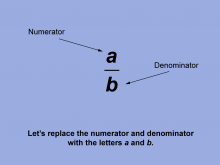
|
Math Clip Art--Fraction Concepts--Proper and Improper Fractions 03 | Math Clip Art--Fraction Concepts--Proper and Improper Fractions 03TopicFractions DescriptionThis image shows a/b for any whole number a and b, with b not equal to zero. It displays the fraction a/b with labels or explanations indicating that a and b can be any whole numbers, but b cannot be zero. This representation introduces students to the general form of a fraction and the important rule that the denominator cannot be zero. It helps students understand that fractions can represent a wide range of values and prepares them for working with variables in algebraic fractions. |
Identify and Name Fractions |
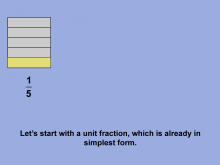
|
Math Clip Art--Fraction Concepts--Equivalent Fractions 06 | Math Clip Art--Fraction Concepts--Equivalent Fractions 06TopicFractions DescriptionThis image starts a short sequence focusing on equivalent fractions of 1/5. It shows a rectangular model divided into five equal parts with one part shaded, representing 1/5. This representation introduces students to the concept of fifths and sets the stage for exploring equivalent fractions with a denominator of 5. It provides a clear visual model for students to understand what 1/5 looks like. Teachers can use this image to begin a discussion about fractions with a denominator of 5 and to prepare students for generating equivalent fractions. |
Find Equivalent Fractions and Identify and Name Fractions |
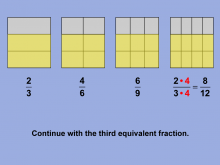
|
Math Clip Art--Fraction Concepts--Equivalent Fractions 14 | Math Clip Art--Fraction Concepts--Equivalent Fractions 14TopicFractions DescriptionThis image shows the final fraction in the sequence: 8/12. It displays a rectangular model divided into twelve parts with eight parts shaded, representing 8/12. It may also include the numerical process of multiplying both the numerator and denominator of 2/3 by 4 to get 8/12. |
Find Equivalent Fractions and Identify and Name Fractions |
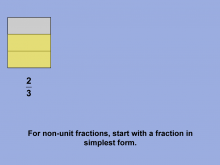
|
Math Clip Art--Fraction Concepts--Equivalent Fractions 11 | Math Clip Art--Fraction Concepts--Equivalent Fractions 11TopicFractions DescriptionThis image starts a new sequence focusing on equivalent fractions of 2/3. It shows a rectangular fraction model divided into three equal parts with two parts shaded, representing 2/3. This representation introduces students to a new fraction and sets the stage for exploring its equivalent forms. It provides a clear visual model for students to understand what 2/3 looks like. Teachers can use this image to begin a discussion about fractions with a numerator greater than 1 and to prepare students for generating equivalent fractions of 2/3. |
Find Equivalent Fractions and Identify and Name Fractions |
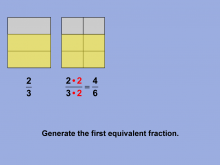
|
Math Clip Art--Fraction Concepts--Equivalent Fractions 12 | Math Clip Art--Fraction Concepts--Equivalent Fractions 12TopicFractions DescriptionThis image shows the next fraction in the sequence: 4/6. It displays a rectangular model divided into six parts with four parts shaded, representing 4/6. It may also include the numerical process of multiplying both the numerator and denominator of 2/3 by 2 to get 4/6. This representation helps students understand how to create equivalent fractions by multiplying both the numerator and denominator by the same number. It provides both a visual and potentially numerical explanation of the process. |
Find Equivalent Fractions and Identify and Name Fractions |

|
Math Clip Art--Fraction Concepts--Equivalent Fractions 08 | Math Clip Art--Fraction Concepts--Equivalent Fractions 08TopicFractions DescriptionThis image continues the sequence, now showing 3/15 with a rectangular model and the numerical process to generate this equivalent fraction. It displays a rectangle divided into 15 parts with three parts shaded, alongside the numerical process of multiplying both the numerator and denominator of 1/5 by 3 to get 3/15. This representation further reinforces the concept of generating equivalent fractions and helps students see the pattern emerging in the sequence. |
Find Equivalent Fractions and Identify and Name Fractions |
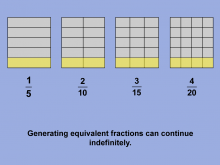
|
Math Clip Art--Fraction Concepts--Equivalent Fractions 10 | Math Clip Art--Fraction Concepts--Equivalent Fractions 10TopicFractions DescriptionThis image serves as a summary slide showing the four equivalent fractions explored in the previous sequence: 1/5, 2/10, 3/15, and 4/20. It displays all four rectangular models side by side, clearly demonstrating their equivalence and reinforcing that this process can continue indefinitely. This representation provides a comprehensive view of the equivalent fractions, allowing students to see the progression and pattern all at once. It reinforces the concept that these fractions, despite looking different, all represent the same amount. |
Find Equivalent Fractions and Identify and Name Fractions |
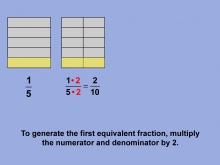
|
Math Clip Art--Fraction Concepts--Equivalent Fractions 07 | Math Clip Art--Fraction Concepts--Equivalent Fractions 07TopicFractions DescriptionThis image builds on the previous one, showing 2/10 with a rectangular model and demonstrating how to generate this equivalent fraction numerically. It displays a rectangle divided into ten parts with two parts shaded, alongside the numerical process of multiplying both the numerator and denominator of 1/5 by 2 to get 2/10. This representation helps students understand how to create equivalent fractions by multiplying both the numerator and denominator by the same number. It provides both a visual and numerical explanation of the process. |
Find Equivalent Fractions and Identify and Name Fractions |
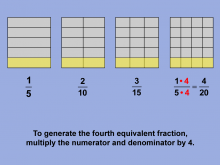
|
Math Clip Art--Fraction Concepts--Equivalent Fractions 09 | Math Clip Art--Fraction Concepts--Equivalent Fractions 09TopicFractions DescriptionThis image completes the short sequence by showing 4/20 with a rectangular model and the numerical process to generate this equivalent fraction. It displays a rectangle divided into 20 parts with four parts shaded, alongside the numerical process of multiplying both the numerator and denominator of 1/5 by 4 to get 4/20. This representation completes the pattern of equivalent fractions for 1/5 and reinforces the concept of generating equivalent fractions by multiplying both the numerator and denominator by the same number. |
Find Equivalent Fractions and Identify and Name Fractions |

|
Math Clip Art--Fraction Concepts--Equivalent Fractions 14 | Math Clip Art--Fraction Concepts--Equivalent Fractions 14TopicFractions DescriptionThis image shows the final fraction in the sequence: 8/12. It displays a rectangular model divided into twelve parts with eight parts shaded, representing 8/12. It may also include the numerical process of multiplying both the numerator and denominator of 2/3 by 4 to get 8/12. |
Find Equivalent Fractions and Identify and Name Fractions |
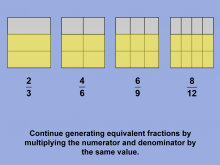
|
Math Clip Art--Fraction Concepts--Equivalent Fractions 15 | Math Clip Art--Fraction Concepts--Equivalent Fractions 15TopicFractions DescriptionThis image serves as a summary slide showing the four equivalent fractions explored in the previous sequence: 2/3, 4/6, 6/9, and 8/12. It displays all four rectangular models side by side, clearly demonstrating their equivalence. |
Find Equivalent Fractions and Identify and Name Fractions |

|
Math Clip Art--Fraction Concepts--Equivalent Fractions 15 | Math Clip Art--Fraction Concepts--Equivalent Fractions 15TopicFractions DescriptionThis image serves as a summary slide showing the four equivalent fractions explored in the previous sequence: 2/3, 4/6, 6/9, and 8/12. It displays all four rectangular models side by side, clearly demonstrating their equivalence. |
Find Equivalent Fractions and Identify and Name Fractions |
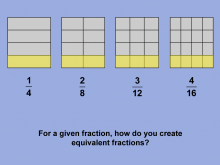
|
Math Clip Art--Fraction Concepts--Equivalent Fractions 05 | Math Clip Art--Fraction Concepts--Equivalent Fractions 05TopicFractions DescriptionThis image shows another variation with rectangular models demonstrating equivalent fractions: 1/4, 2/8, 3/12, and 4/16. It displays four rectangles side by side, each divided and shaded to represent these fractions. This representation further reinforces the concept of equivalent fractions using a different set of fractions. It helps students see the pattern in creating equivalent fractions by multiplying both the numerator and denominator by the same number. |
Find Equivalent Fractions and Identify and Name Fractions |
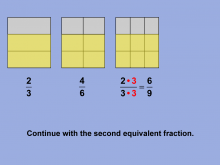
|
Math Clip Art--Fraction Concepts--Equivalent Fractions 13 | Math Clip Art--Fraction Concepts--Equivalent Fractions 13TopicFractions DescriptionThis image continues the sequence, now showing 6/9. It displays a rectangular model divided into nine parts with six parts shaded, representing 6/9. It may also include the numerical process of multiplying both the numerator and denominator of 2/3 by 3 to get 6/9. This representation further reinforces the concept of generating equivalent fractions and helps students see the pattern emerging in the sequence. Teachers can use this image to continue the discussion on equivalent fractions and to encourage students to predict the next fraction in the sequence. |
Find Equivalent Fractions and Identify and Name Fractions |

|
Math Clip Art--Fraction Concepts--Equivalent Fractions 14 | Math Clip Art--Fraction Concepts--Equivalent Fractions 14TopicFractions DescriptionThis image shows the final fraction in the sequence: 8/12. It displays a rectangular model divided into twelve parts with eight parts shaded, representing 8/12. It may also include the numerical process of multiplying both the numerator and denominator of 2/3 by 4 to get 8/12. |
Find Equivalent Fractions and Identify and Name Fractions |
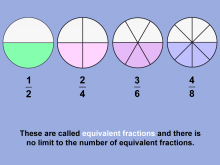
|
Math Clip Art--Fraction Concepts--Equivalent Fractions 03 | Math Clip Art--Fraction Concepts--Equivalent Fractions 03TopicFractions DescriptionThis image displays circular fraction models that are equivalent: 1/2, 2/4, 3/6, and 4/8. It shows four circles side by side, each divided and shaded to represent these fractions. This visual representation expands on the previous image, showing multiple equivalent fractions. It helps students see the pattern in equivalent fractions and understand that as both the numerator and denominator are multiplied by the same number, the fraction's value remains the same. Teachers can use this image to discuss patterns in equivalent fractions and to introduce the concept of simplifying and expanding fractions. |
Find Equivalent Fractions and Identify and Name Fractions |
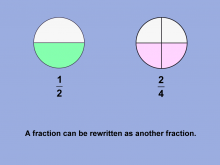
|
Math Clip Art--Fraction Concepts--Equivalent Fractions 02 | Math Clip Art--Fraction Concepts--Equivalent Fractions 02TopicFractions DescriptionThis image presents circular fraction models for 1/2 and 2/4, illustrating that equal fractions can be written in different forms. It shows two circles side by side, one divided into two equal parts with one part shaded (representing 1/2), and the other divided into four equal parts with two parts shaded (representing 2/4). This visual representation helps students understand that fractions can look different but represent the same amount. It introduces the fundamental concept of equivalent fractions using a familiar circular model. |
Find Equivalent Fractions and Identify and Name Fractions |

|
Math Clip Art--Fraction Concepts--Equivalent Fractions 15 | Math Clip Art--Fraction Concepts--Equivalent Fractions 15TopicFractions DescriptionThis image serves as a summary slide showing the four equivalent fractions explored in the previous sequence: 2/3, 4/6, 6/9, and 8/12. It displays all four rectangular models side by side, clearly demonstrating their equivalence. |
Find Equivalent Fractions and Identify and Name Fractions |

|
Math Clip Art--Fraction Concepts--Equivalent Fractions 14 | Math Clip Art--Fraction Concepts--Equivalent Fractions 14TopicFractions DescriptionThis image shows the final fraction in the sequence: 8/12. It displays a rectangular model divided into twelve parts with eight parts shaded, representing 8/12. It may also include the numerical process of multiplying both the numerator and denominator of 2/3 by 4 to get 8/12. |
Find Equivalent Fractions and Identify and Name Fractions |
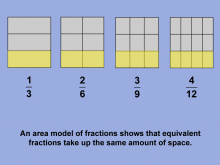
|
Math Clip Art--Fraction Concepts--Equivalent Fractions 04 | Math Clip Art--Fraction Concepts--Equivalent Fractions 04TopicFractions DescriptionThis image presents a variation with rectangular models showing equivalent fractions: 1/3, 2/6, 3/9, and 4/12. It displays four rectangles side by side, each divided and shaded to represent these fractions. This representation introduces a new model for understanding equivalent fractions. It helps students see that the concept of equivalent fractions applies across different visual representations and reinforces the pattern of multiplying both numerator and denominator by the same number. |
Find Equivalent Fractions and Identify and Name Fractions |

|
Math Clip Art--Fraction Concepts--Equivalent Fractions 01 | Math Clip Art--Fraction Concepts--Equivalent Fractions 01TopicFractions DescriptionThis image serves as the title card for a series on equivalent fractions. It displays the text "Equivalent Fractions" in a clear, prominent font. The background may include subtle mathematical elements or fraction-related graphics to set the context for the following images in the series. This introductory image sets the stage for the subsequent images, preparing students for an exploration of fractions that have the same value but are written differently. It provides a clear, concise title that immediately informs viewers about the specific fraction concepts they'll be studying. |
Find Equivalent Fractions and Identify and Name Fractions |

|
Math Clip Art--Fraction Concepts--Equivalent Fractions 15 | Math Clip Art--Fraction Concepts--Equivalent Fractions 15TopicFractions DescriptionThis image serves as a summary slide showing the four equivalent fractions explored in the previous sequence: 2/3, 4/6, 6/9, and 8/12. It displays all four rectangular models side by side, clearly demonstrating their equivalence. |
Find Equivalent Fractions and Identify and Name Fractions |
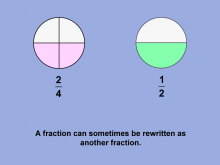
|
Math Clip Art--Fraction Concepts--Fractions in Simplest Form 02 | Math Clip Art--Fraction Concepts--Fractions in Simplest Form 02TopicFractions DescriptionThis image shows equivalent circular fraction models for 2/4 and 1/2. It displays two circles side by side, one divided into four equal parts with two parts shaded (representing 2/4), and the other divided into two equal parts with one part shaded (representing 1/2). This visual representation helps students understand that fractions can be equivalent even when written differently. It introduces the concept of simplifying fractions by showing that 2/4 and 1/2 represent the same portion of a whole. |
Identify and Name Fractions |
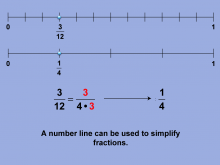
|
Math Clip Art--Fraction Concepts--Fractions in Simplest Form 08 | Math Clip Art--Fraction Concepts--Fractions in Simplest Form 08TopicFractions DescriptionThis image is a variation of the previous one, now showing the equivalence of 3/12 and 1/4 on number lines. It displays two number lines, one marked from 0 to 1 with 12 equal divisions and a point at 3/12, and another marked from 0 to 1 with 4 equal divisions and a point at 1/4. This representation further reinforces the concept of equivalent fractions using number lines. It helps students visualize how fractions with different denominators can represent the same value. |
Identify and Name Fractions |
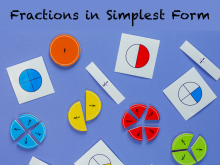
|
Math Clip Art--Fraction Concepts--Fractions in Simplest Form 01 | Math Clip Art--Fraction Concepts--Fractions in Simplest Form 01TopicFractions DescriptionThis image serves as the title card for a series on fractions in simplest form. It likely displays the text "Fractions in Simplest Form" in a clear, prominent font. The background may include subtle mathematical elements or fraction-related graphics to set the context for the following images in the series. This introductory image sets the stage for the subsequent images, preparing students for an exploration of equivalent fractions and the process of simplifying fractions. It provides a clear, concise title that immediately informs viewers about the specific fraction concepts they'll be studying. |
Identify and Name Fractions |
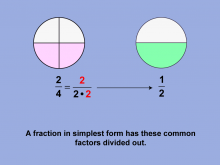
|
Math Clip Art--Fraction Concepts--Fractions in Simplest Form 04 | Math Clip Art--Fraction Concepts--Fractions in Simplest Form 04TopicFractions DescriptionThis image continues from the previous one, showing how common factors divide out when simplifying fractions. It likely displays the process of simplifying 2/4 to 1/2 with a focus on the common factor of 2, possibly using visual elements like circles or arrows to show how the common factor is removed from both the numerator and denominator. This representation helps students understand the mathematical principle behind simplifying fractions. It visually demonstrates that we're dividing both the numerator and denominator by the same number, which doesn't change the fraction's value. |
Identify and Name Fractions |
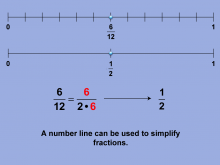
|
Math Clip Art--Fraction Concepts--Fractions in Simplest Form 07 | Math Clip Art--Fraction Concepts--Fractions in Simplest Form 07TopicFractions DescriptionThis image shows fraction number lines demonstrating the equivalence of 6/12 and 1/2. It displays two number lines, one marked from 0 to 1 with 12 equal divisions and a point at 6/12, and another marked from 0 to 1 with 2 equal divisions and a point at 1/2. This representation introduces a new model for understanding equivalent fractions and fraction simplification. It helps students visualize fractions on a linear scale and reinforces the concept that equivalent fractions occupy the same point on a number line. |
Identify and Name Fractions |
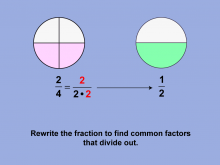
|
Math Clip Art--Fraction Concepts--Fractions in Simplest Form 03 | Math Clip Art--Fraction Concepts--Fractions in Simplest Form 03TopicFractions DescriptionThis image is a variation of the previous one, showing how to simplify 2/4. It displays the process of simplifying 2/4 to 1/2, using notation to show the division of both the numerator and denominator by their greatest common factor (2 in this case). This representation helps students understand the process of simplifying fractions. It visually demonstrates that simplifying a fraction doesn't change its value, but expresses it in its lowest terms. Teachers can use this image to explain the process of simplifying fractions and to reinforce the concept of equivalent fractions. |
Identify and Name Fractions |

|
Math Clip Art--Fraction Concepts--Fractions in Simplest Form 05 | Math Clip Art--Fraction Concepts--Fractions in Simplest Form 05TopicFractions DescriptionThis image is a variation showing the equivalence of 6/8 and 3/4. It displays two circular fraction models side by side, one divided into eight parts with six shaded (representing 6/8), and the other divided into four parts with three shaded (representing 3/4). This visual representation helps students see that 6/8 and 3/4 represent the same portion of a whole, reinforcing the concept of equivalent fractions. It also provides another example of simplifying fractions, this time with a different common factor. |
Identify and Name Fractions |
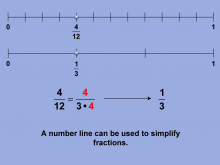
|
Math Clip Art--Fraction Concepts--Fractions in Simplest Form 09 | Math Clip Art--Fraction Concepts--Fractions in Simplest Form 09TopicFractions DescriptionThis image is another variation, now demonstrating the equivalence of 4/12 and 1/3 on number lines. It shows two number lines, one marked from 0 to 1 with 12 equal divisions and a point at 4/12, and another marked from 0 to 1 with 3 equal divisions and a point at 1/3. This representation continues to build on the concept of equivalent fractions using number lines. It helps students visualize how fractions with different denominators can represent the same value, even when the relationship isn't as immediately obvious as in previous examples. |
Identify and Name Fractions |